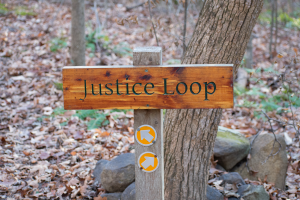
The modern Justice family is descended from some of the first enslaved people ever recorded at Stagville: Ned, Esther, Betty, and Cato. Photo by Don Kinney.
Since 2012, we have worked to help tell the story of the land at our nature preserves. That year, TLC opened Horton Grove Nature Preserve and named the trails in honor of the descendants of enslaved Black people who were forced to live and work on the land for generations. We’ve also worked to document and share the histories of Black and Indigenous communities at the Bailey and Sarah Williamson Preserve.
In 2016, TLC hired a third party to complete an equity audit, which revealed several areas for improvement that have guided TLC’s conduct as an employer, community representative, and recreational resource. Following this audit, TLC recognized that since 1983, many of the organization’s projects have reflected the lack of diversity in land ownership. Uncovering and understanding both our state’s and our own history has made it impossible to ignore the people who stewarded, cultivated, and cared for the lands we now conserve without official recognition in the ownership structure or a share in the wealth that land yields.
Though North Carolina is home to a long lineage of Indigenous and Black land stewards, they are scarcely reflected in land ownership and agriculture. In 1920, Black farmers owned 14 percent of American farms. Today however, they account for 1.4 percent of the country’s 3.4 million producers.
In 1997, a North Carolina farmer brought what would become the largest civil rights class action lawsuit in our country’s history. Leveled against the U.S. Department of Agriculture, the Pigford v. Glickman case uncovered systemic discrimination against Black farmers and helped lay the groundwork for two decades of further legal action by Indigenous, Latinx, and female farmers.
While monetary relief flowed from these settlements, structural change was not forthcoming. Today, 98 percent of farmland is owned by white producers and much of it is under threat of development. Without a concerted, long-term effort, this profound inequity will continue to burden not only rural communities but American agriculture and land stewardship for generations to come.
TLC has protected more than 4,000 acres of farmland since 1983 in the Triangle region, which is under enormous pressure from development. Between 2001 and 2016, more than 731,600 acres of agricultural land in North Carolina were developed or compromised. Of the 46,000 farms that remain in the state, there are five times as many farmers over the age of 65 as under 35. With the population of North Carolina growing nearly 10% in just 10 years, TLC recognizes the urgency of creating opportunities for younger farmers to secure critical land and sustainably grow food on it.
The reality of historic discrimination and present-day farmland loss in North Carolina helped define the Good Ground Initiative’s main objectives to address. We understand the necessity of administering equity-based programs with measurable outcomes, such that in the process of doing conservation, TLC will engage in the reversal of disparities in land stewardship and wealth building.
